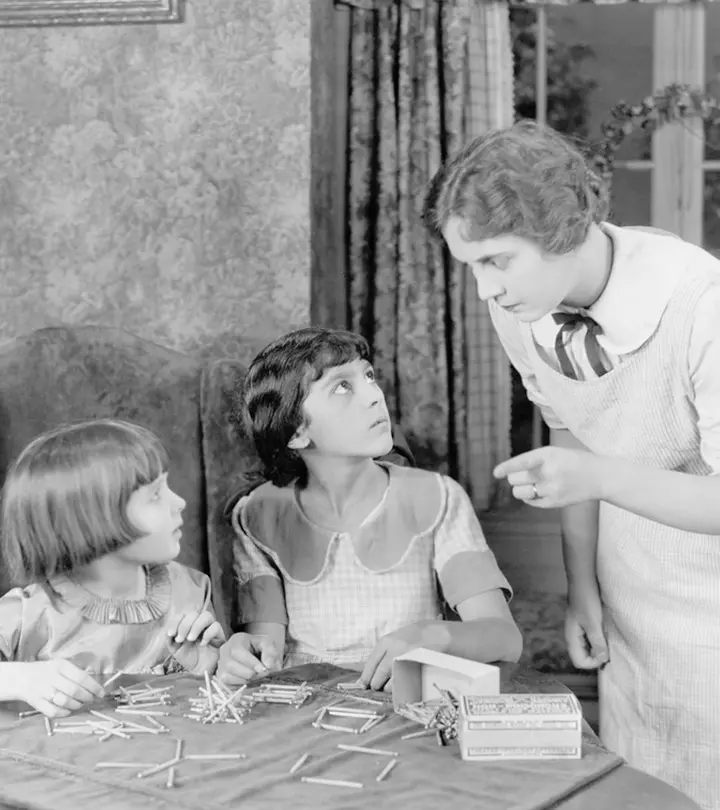
Image: Shutterstock
Parenting is never easy and never has been. Throughout history, each generation has come up with their own imagination of how they would mould their kids. While it seems like something that has been going on for ages, not two parenting styles are the same. On the contrary, they actually contradict one another. In ancient times, parents did not have the luxury of researching or backing a fact with scientific evidence. They simply went for what others followed and what felt instinctively. While some worked out for them, others, not so much! Let’s read some of the parenting tips from history that are nothing but frightening to us now.
1. Lard Was Used For Bathing Newborns
Midway through the nineteenth century, the mother’s guidebook advocated bathing the infant to remove the pasty material that coated their skin, otherwise called vernix caseosa. The infant was bathed with a sponge, soap, & warm water after being well-smeared and gently massaged with fat or oil.
2. Arsenic Was Innocently Stored Around Newborns
An artificial dye with a stunning emerald green hue was popular during Victorian times. Wallpaper, clothes, artificial flowers, and even baby carriages used the colour prominently. Unfortunately, arsenic, an extremely hazardous chemical, was the raw ingredient used to make this colour.
3. Breastfeeding Was Once Frowned Upon
Breastfeeding was considered unfashionable for aristocratic ladies during the Renaissance. They were also worried about their appearance, social isolation, and inability to wear the day’s fashionable clothing. As a result, they hired a wet nurse to take care of babies’ feedings. In the late nineteenth century, they advised young spouses against breastfeeding for more than nine months since it might induce brain damage in children and blinding disabilities for mothers.
4. Children Were Smeared With Quinine On Their Fingertip
Quinine is a strong medicine solely used to treat malaria and babesiosis (1). It is presently the only therapy available. A book published in 1916 proposed painting the fingers of newborns with this medicine to keep them from sucking or chewing their nails (2).
5. They Were Careful Not To Get Excessively Affectionate With The Kids
Excessive maternal love could be dangerous, according to a 1928 book by famous psychologist John B. Watson (3). At the time, it was thought that spoiling a newborn would lead to a lack of strong character formation. So parents would instil manners in the offspring without being affectionate towards them.
6. A Few Weeks Or Even Days After Birth, Infants Were Made To Ingest Solid Meals
Based on the findings of postwar research, it was suggested that women began weaning their babies onto solids at 6 weeks old. Similarly, doctors in the early 1960s advocated that 2-day-old newborns be fed cereal and that they should be given “grown-up liquids,” such as coffee or tea, from the age of six or seven months (4). How lucky are we to be born in this generation!
7. Kids Were Not Allowed To Be Left-Handed
In the twentieth century, children born with a dominant left hand were often made to utilise their right thumb for everyday tasks. The forced transition was supposed to rectify the stubborn mentality of a youngster who preferred to use their left hand. However, when they sought to use their left hand, they were warned with a penalty, such as binding their left hand up. How cruel and ignorant is that!
8. Infants Were Placed In A Car Hammock Or A Basket When Travelling
Honestly, it could have been worse! In the 1930s, pamphlets advised parents to carry their newborns in a fruit basket since it was the most pleasant and easy method of going around with the kids. This was deemed safe as the kids would not move freely as they would on the lap or on the seat itself.
9. Babies Would Have To Sleep On Their Stomachs
Baby sleeping on their stomach was widely advocated between 1970 and 1980 by child-care professionals (5). They believed it was the best posture for children. But they were unaware that it may lead to abrupt death in little newborns until a campaign initiated in 1994. Thankfully, the number of cases dropped to less than half of what it had been in the 1990s.
Ancient times did have some wild ideas about parenting, didn’t they! Parenting styles keep changing from generation to generation, and while these ideas seem totally absurd to us, maybe a few years later, future generations will be equally amused by ours. Therefore, researching the technique and seeing that your child is comfortable and progressing through it is essential. So, which among these styles did you find the most amusing? Let us know in the comments section. Happy Parenting!












